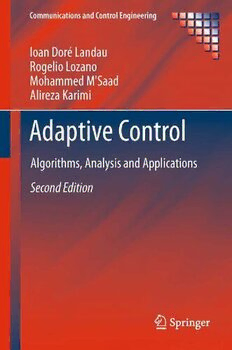Table Of ContentCommunications and Control Engineering
Forothertitlespublishedinthisseries,goto
www.springer.com/series/61
SeriesEditors
(cid:2) (cid:2) (cid:2) (cid:2)
A.Isidori J.H.vanSchuppen E.D.Sontag M.Thoma M.Krstic
Publishedtitlesinclude:
StabilityandStabilizationofInfiniteDimensional SwitchedLinearSystems
SystemswithApplications ZhendongSunandShuzhiS.Ge
Zheng-HuaLuo,Bao-ZhuGuoandOmerMorgul
SubspaceMethodsforSystemIdentification
NonsmoothMechanics(Secondedition) TohruKatayama
BernardBrogliato
DigitalControlSystems
NonlinearControlSystemsII IoanD.LandauandGianlucaZito
AlbertoIsidori
MultivariableComputer-controlledSystems
L2-GainandPassivityTechniquesinNonlinearControl EfimN.RosenwasserandBernhardP.Lampe
ArjanvanderSchaft
DissipativeSystemsAnalysisandControl
ControlofLinearSystemswithRegulationandInput (Secondedition)
Constraints BernardBrogliato,RogelioLozano,BernhardMaschke
AliSaberi,AntonA.StoorvogelandPeddapullaiah andOlavEgeland
Sannuti
AlgebraicMethodsforNonlinearControlSystems
RobustandH∞Control GiuseppeConte,ClaudeH.MoogandAnnaM.Perdon
BenM.Chen
PolynomialandRationalMatrices
ComputerControlledSystems TadeuszKaczorek
EfimN.RosenwasserandBernhardP.Lampe
Simulation-basedAlgorithmsforMarkovDecision
ControlofComplexandUncertainSystems Processes
StanislavV.EmelyanovandSergeyK.Korovin HyeongSooChang,MichaelC.Fu,JiaqiaoHuand
StevenI.Marcus
RobustControlDesignUsingH∞Methods
IanR.Petersen,ValeryA.Ugrinovskiand IterativeLearningControl
AndreyV.Savkin Hyo-SungAhn,KevinL.MooreandYangQuanChen
ModelReductionforControlSystemDesign DistributedConsensusinMulti-vehicleCooperative
GoroObinataandBrianD.O.Anderson Control
WeiRenandRandalW.Beard
ControlTheoryforLinearSystems
HarryL.Trentelman,AntonStoorvogelandMaloHautus ControlofSingularSystemswithRandomAbrupt
Changes
FunctionalAdaptiveControl
El-KébirBoukas
SimonG.FabriandVisakanKadirkamanathan
NonlinearandAdaptiveControlwithApplications
Positive1Dand2DSystems
AlessandroAstolfi,DimitriosKaragiannisandRomeo
TadeuszKaczorek
Ortega
IdentificationandControlUsingVolterraModels
Stabilization,OptimalandRobustControl
FrancisJ.DoyleIII,RonaldK.PearsonandBabatunde
AzizBelmiloudi
A.Ogunnaike
ControlofNonlinearDynamicalSystems
Non-linearControlforUnderactuatedMechanical
FelixL.Chernous’ko,IgorM.AnanievskiandSergey
Systems
A.Reshmin
IsabelleFantoniandRogelioLozano
PeriodicSystems
RobustControl(Secondedition)
SergioBittantiandPatrizioColaneri
JürgenAckermann
DiscontinuousSystems
FlowControlbyFeedback
YuryV.Orlov
OleMortenAamoandMiroslavKrstic
ConstructionsofStrictLyapunovFunctions
LearningandGeneralization(Secondedition)
MichaelMalisoffandFrédéricMazenc
MathukumalliVidyasagar
ControllingChaos
ConstrainedControlandEstimation
HuaguangZhang,DerongLiuandZhiliangWang
GrahamC.Goodwin,MariaM.Seronand
JoséA.DeDoná StabilizationofNavier-StokesFlows
ViorelBarbu
RandomizedAlgorithmsforAnalysisandControl
ofUncertainSystems DistributedControlofMulti-agentNetworks
RobertoTempo,GiuseppeCalafioreandFabrizio WeiRenandYongcanCao
Dabbene
Ioan Doré Landau (cid:2) Rogelio Lozano (cid:2)
Mohammed M’Saad (cid:2) Alireza Karimi
Adaptive Control
Algorithms, Analysis and Applications
Second Edition
Prof.IoanDoréLandau Prof.MohammedM’Saad
Départementd’Automatique CentredeRecherche(ENSICAEN)
GIPSA-LAB(CNRS/INPG/UJF) LaboratoireGREYC
POBox46 ÉcoleNationaleSupérieured’Ingénieurs
38402St.Martind’Heres deCaen
France CampusCôtedeNacre
[email protected] bd.MaréchalJuin6
14032CaenCedex
Prof.RogelioLozano France
UMR-CNRS6599 [email protected]
CentredeRecherchedeRoyalieu
HeuristiqueetDiagnosticdesSystèmes Prof.AlirezaKarimi
Complexes Laboratoired’Automatique
UniversitédeTechnologiedeCompiègne
ÉcolePolytechniqueFédéraledeLausanne
POBox20529
1015Laussanne
60205Compiègne
Switzerland
France
alireza.karimi@epfl.ch
[email protected]
ISSN0178-5354
ISBN978-0-85729-663-4 e-ISBN978-0-85729-664-1
DOI10.1007/978-0-85729-664-1
SpringerLondonDordrechtHeidelbergNewYork
BritishLibraryCataloguinginPublicationData
AcataloguerecordforthisbookisavailablefromtheBritishLibrary
LibraryofCongressControlNumber:2011930651
©Springer-VerlagLondonLimited2011
Apartfromanyfairdealingforthepurposesofresearchorprivatestudy,orcriticismorreview,asper-
mittedundertheCopyright,DesignsandPatentsAct1988,thispublicationmayonlybereproduced,
storedortransmitted,inanyformorbyanymeans,withthepriorpermissioninwritingofthepublish-
ers,orinthecaseofreprographicreproductioninaccordancewiththetermsoflicensesissuedbythe
CopyrightLicensingAgency.Enquiriesconcerningreproductionoutsidethosetermsshouldbesentto
thepublishers.
Theuseofregisterednames,trademarks,etc.,inthispublicationdoesnotimply,evenintheabsenceofa
specificstatement,thatsuchnamesareexemptfromtherelevantlawsandregulationsandthereforefree
forgeneraluse.
Thepublishermakesnorepresentation,expressorimplied,withregardtotheaccuracyoftheinformation
containedinthisbookandcannotacceptanylegalresponsibilityorliabilityforanyerrorsoromissions
thatmaybemade.
Coverdesign:VTeXUAB,Lithuania
Printedonacid-freepaper
SpringerispartofSpringerScience+BusinessMedia(www.springer.com)
To Lina,Leticia,Salima,Noushin
Vlad,Jessica, Rogelio,AzadehandOmid
Cequiestsimpleesttoujours faux
Cequinel’estpas estinutilisable
PaulValéry
Mauvaises Pensées
Preface
Adaptivecontrolprovidestechniquesfortheautomaticadjustmentofcontrolparam-
etersinrealtimeeithertoachieveortomaintainadesiredlevelofcontrolsystem
performancewhenthe dynamicparameters of the process to be controlledare un-
knownand/ortime-varying.Themaincharacteristicofthesetechniquesistheability
toextractsignificantinformationfromrealdatainordertotunethecontrollerand
theyfeatureamechanismforadjustingtheparametersofeithertheplantmodelor
thecontroller.Thehistoryofadaptivecontrolislong,significantprogressinunder-
standing and applying its ideas having begun in the early nineteen-seventies. The
growingavailabilityofdigitalcomputershasalsocontributedtotheprogressionof
the field. The early applications provided important feedback for the development
of the field and theoretical innovations allowed a number of basic problems to be
solved.Theaimofthisbookistoprovideacoherentandcomprehensivetreatment
ofthefieldofadaptivecontrol.Thepresentationtakesthereaderfrombasicproblem
formulationtoanalyticalsolutionsthepracticalsignificanceofwhichisillustrated
byapplications.Aunifiedpresentationofadaptivecontrolisnotobvious.Onerea-
son for this is that several design steps are involvedand this increases the number
ofdegreesoffreedom.Anotheristhatmethodshavebeenproposedhavingdiffer-
entapplicationsinmindbutwithoutaclearmotivationfortheintermediatedesign
steps.Itisourbelief,however,thatacoherentpresentationofthebasictechniques
ofadaptivecontrolisnowpossible.Wehaveadoptedadiscrete-timeformulationfor
theproblemsandsolutionsdescribedtoreflecttheimportanceofdigitalcomputers
in the application of adaptive control techniques and we share our understanding
andpracticalexperienceofthesoundnessofvariouscontroldesignswiththereader.
Throughoutthebook,themathematicalaspectsofthesynthesisandanalysisofvar-
iousalgorithmsareemphasized;however,thisdoesnotmeanthattheyaresufficient
inthemselvesforsolvingpracticalproblemsorthatadhocmodificationsofthealgo-
rithmsforspecificapplicationsarenotpossible.Toguidereaders,thebookcontains
various applications of control techniques but it is our belief that without a solid
mathematicalunderstandingoftheadaptationtechniquesavailable,theywillnotbe
abletoapplythemcreativelytonewanddifficultsituations.Thebookhasgrownout
ofseveralsurveypapers,tutorialandcoursesdeliveredtovariousaudiences(grad-
uatestudents,practicingengineers,etc.)invariouscountries,oftheresearchinthe
vii
viii Preface
fielddonebytheauthors(mostlyatLaboratoired’AutomatiquedeGrenoble,now
theControlDepartmentofGIPSA-LAB(InstitutNationalPolytechniquedeGreno-
ble/CNRS),HEUDYASIC(UniversitéTechnologiquedeCompiègne/CNRS),CIN-
VESTAV (Mexico), GREYC (Caen) and the Laboratoire d’Automatique of EPFL
(Lausanne)), and of the long and rich practical experience of the authors. On the
one hand, this new edition reflects new developments in the field both in terms of
techniques and applications and, on the other, it puts a number of techniques into
properperspectiveasaresultoffeedbackfromapplications.
ExpectedAudience Thebookisintendedasatextbookforgraduatestudentsas
well as a basic reference for practicing engineers facing the problem of designing
adaptivecontrolsystems.Controlresearchersfromotherareaswillfindacompre-
hensivepresentationof the field with bridges to various other control design tech-
niques.
AbouttheContent Itiswidelyacceptedthatstabilityanalysisinadeterministic
environmentandconvergenceanalysisinastochasticenvironmentconstituteabasic
groundingforanalysisanddesignofadaptivecontrolsystemsandsotheseformthe
coreofthetheoreticalaspectsofthebook.Parametricadaptationalgorithms(PAAs)
whicharepresentinalladaptivecontroltechniquesareconsideredingreaterdepth.
Our practical experience has shown that in the past the basic linear controller
designswhichmakeupthebackgroundforvariousadaptivecontrolstrategieshave
oftennottakenrobustnessissuesintoaccount.Itisbothpossibleandnecessaryto
accommodatetheseissuesbyimprovingtherobustnessofthelinearcontroldesigns
priortocouplingthemwithoneoftheadaptationalgorithmssothebookcoversthis.
Inthecontextofadaptivecontrol,robustnessalsoconcernstheparameteradap-
tationalgorithmsandthisissueisaddressedindetail.Furthermore,multiple-model
adaptive control with switching is an illustration of the combination of robust and
adaptive control and is covered in depth in the new edition. In recent years, plant
model identification in closed-loop operation has become more and more popular
asawayofimprovingtheperformanceofanexistingcontroller.Themethodsthat
havearisenasaresultaredirectlyrelevanttoadaptivecontrolandwillalsobethor-
oughlytreated.Adaptiveregulationandadaptivefeedforwarddisturbancecompen-
sationhaveemergedasnewadaptivecontrolproblemswithimmediateapplication
inactivevibrationcontrolandactivenoisecontrol.Theseaspectsarenowcovered
inthissecondedition.
Thebookisorganizedasfollows:
• Chapter1providesanintroductiontoadaptivecontrolandatutorialpresentation
ofthevarioustechniquesinvolved.
• Chapter2presentsabriefreviewofdiscrete-timelinearmodelsforcontrolwith
emphasisonoptimalpredictorswhichareoftenusedthroughoutthebook.
• Chapter3isathoroughcoverageofparameteradaptationalgorithms(PAA)oper-
atinginadeterministicenvironment.Variousapproachesarepresentedandthen
thestabilitypointofviewforanalysisanddesignisdiscussedindetail.
Preface ix
• Chapter 4 is devoted to the analysis of parameter adaptation algorithms in a
stochasticenvironment.
• Chapter 5 discusses recursive plant model identification in open loop which is
an immediate application of PAAs on the one hand and an unavoidable step in
startinganadaptivecontrollerontheother.
• Chapter6isdevotedtothesynthesisofadaptivepredictors.
• Chapter7coversdigitalcontrolstrategieswhichareusedinadaptivecontrol.One
stepaheadpredictivecontrolandlong-rangepredictivecontrolarepresentedina
unifiedmanner.
• Chapter8discussestherobustdigitalcontroldesignproblemandprovidestech-
niquesforachievingrequiredrobustnessbyshapingthesensitivityfunctions.
• Digitalcontroltechniquescanbecombinedwiththerecursiveplantmodeliden-
tificationinclosedlooptoobtainanadaptivecontroller.Theserecursiveidentifi-
cationtechniquesarediscussedinChap.9.
• The issue of robustification of parameter adaptation algorithm in the context of
adaptivecontrolisaddressedinChap.10.
• For special types of plant model structures and control strategies, appropriate
parametrizationoftheplantmodelallowsdirectadjustmentoftheparametersof
thecontrollersyieldingsocalleddirectadaptivecontrolschemes.Directadaptive
controlisthesubjectofChap.11.
• Indirectadaptivecontrolwhichcombinesinreal-timeplantmodelparameteresti-
mationinclosedloopwiththeredesignofthecontrollerisdiscussedinChap.12.
• Multimodeladaptivecontrolwithswitching,whichcombinesrobustcontroland
adaptivecontrol,isdiscussedinChap.13(newinthesecondedition).
• Rejectionofunknowndisturbancesistheobjectiveofadaptiveregulationwhich
isthesubjectofChap.14(newinthesecondedition).
• Adaptive feedforward compensation of disturbances is discussed in Chap. 15
(newinthesecondedition).
• Chapter 16 is devoted to the practical aspects of implementing adaptive con-
trollers.
Chapters5,9,12,13,14and15includeapplicationsusingthetechniquespresented
inthesechapters.Anumberofappendiceswhichsummarizeimportantbackground
topicsareincluded.
Problemsandsimulationexercisesareincludedinmostofthechapters.
Pathways Through the Book The book was written with the objective of pre-
sentingcomprehensivecoverageofthefieldofadaptivecontrolandofmakingthe
subjectaccessibletoalargeaudiencewithdifferentbackgroundsandinterests.Thus
thebookcanbereadandusedindifferentways.
For those only interested in applications we recommend the following se-
quence: Chaps.: 1, 2, 3 (Sects. 3.1 and 3.2), 5 (Sects. 5.1, 5.2, 5.7 through 5.9),
7 (Sects. 7.1, 7.2, 7.3.1 and 7.3.2), 8 (Sects. 8.1, 8.2 and 8.3.1), 9 (Sects. 9.1
and 9.6), 10 (Sect. 10.1), 11 (Sects. 11.1 and 11.2), 12 (Sects. 12.1 and 12.2.1),
13(Sects.13.1,13.2and13.4),14(Sects.14.1,14.2,14.4and14.7),15(Sects.15.1,
15.2 and 15.5) and Chap.16. Most of the content of Chaps. 14 and 15 can also be

